#opcode
Explore tagged Tumblr posts
Text
DBPF Compare - Updated
DBPF Compare V1.8
Fixed issue with BHAV instructions incorrectly reporting the OpCode/Primitive
#sims2tools#dbpf compare#bhav#opcode#primitive#diff#updated#c-sharp#source code#simblr#ts2#sims 2#the sims 2
11 notes
·
View notes
Text
Low-level, Middle-level, and High-level Programming Languages
#NeedToKnow: level of languages
Low-level Programming LanguagesMiddle-level Programming LanguagesHigh-level Programming LanguagesMachine Language: This is the lowest level of programming language, consisting of binary code understood directly by the computer’s hardware. Each instruction directly corresponds to a hardware operation.Assembly Language: Slightly higher level than machine language, assembly language uses mnemonic…
View On WordPress
0 notes
Text
This is probably just full programmer projection but how pissed do you think Turbo was when fifth gen games started rolling into the arcade? Guy takes all this time to learn code and learn the different assembly languages like z80 and 6502 and maybe even m68k and he's probably reaching a point where he thinks he has it all figured out.
And then around the mid-ish 90s games along the same vein as Sugar Rush start coming out.
And now not only are they running on an assembly language Turbo had probably not seen before (MIPS), but they're also being programmed mostly in C, a completely different language that he will be learning for the first time without the help of any book or reference cards.
And so now he's almost worse off, because not only does he have to juggle figuring out which MIPS opcodes are the same and which opcodes are different from the previous assembly languages he learned (and handling 32 bit architecture) but now he's also gotta learn what inline embedding is and how to do it in a language he is only now encountering.
Oh to be a fly on the wall (or bug in the code lmao) when he was dealing with that.
#wreck it ralph#turbo wir#headcanons#full projection at this point but I'm having fun lol#bc Turbo canonically knowing how to code will never not be fun for me#there's just so much I can add onto him from that angle it's great#especially the idea of Turbo fucking up the opcodes with the different assemblers#bc they can be really close and then you'll get to the one part where it diverges and not realize it#and that's even with the ref cards within reach. this guy had none of that how many mistakes did he make?#I wanna audit the code he wrote
32 notes
·
View notes
Text

USA 1993
15 notes
·
View notes
Text
I wanted to see if our friend The World's Dumbest Robot could figure out the extremely simple process of "set bit L of register A" in z80 assembly, and the results were...consistent.

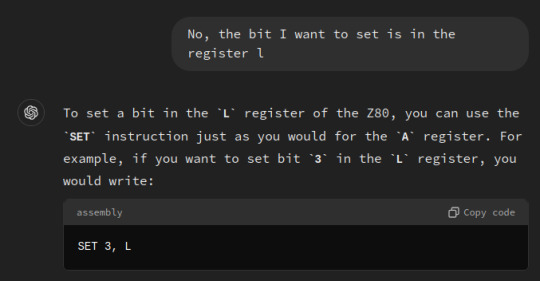






What a moron.
#my thoughts#programming#chatgpt#assembly#i think it was getting confused with 8086 assembly?#'cause it kept trying to use totally hallucinated combinations of opcodes and operands#like OR A‚ B#or trying to use CP 0#to compare either the C or L registers to 0#like what are you even doing
10 notes
·
View notes
Text
fuck it be free my notes from last night

#original art!#i do know it is much easier to work out from existing toolsets (i.e. just learn ASM for whatever) but ever since I figured out how to make#CPU out of logic units the idea of working up from there to a full computer has been burning its way through my brain. So opcodes that are#grab bag of stuff that came to mind and a handful of codes from the 6502#along with some loose ideas on memory mapping though im not really educated at all on that.#the idea of a computer that can virtually handle radio is interesting to me though--on top of the more general CPU & Computer & OS#Whatever my CS followers will probably eviscerate me for some glaring flaws and i accept this burden.
2 notes
·
View notes
Text

Make music on vintage computer MIDI sequencers. Presented by Deep Signal Studios.
February 15th and 16th, Saturday & Sunday, 2025
Hotel Fera Event Center, Orange, Ca
https://www.vcfsocal.com/
#synth#midi#roland#opcode systems#texture#Orange County#vintagecomputerfestsocal#vintage computer#retro computing#Emu#Yamaha DX7
1 note
·
View note
Text
Advanced WordPress Caching

Speed is important in the fast-paced world of online presence. Users expect websites to load in the blink of an eye, and search engines reward faster sites with better rankings. If you’re a WordPress enthusiast, you probably already know how crucial caching is to maximising the functionality of your website. We’ll explore sophisticated WordPress caching strategies in this blog post, which can significantly increase the speed of your website.
#WordPress Caching#Advanced Caching Techniques#Browser Caching#Browser Caching in WordPress#CDN Integration for WordPress Caching#Fragment Caching#JNext#JNext Services#Object Caching in WordPress#Opcode Caching for WordPress#Page Caching Best Practices#Performance Optimization with WordPress Caching#Redis Cache for WordPress#Server-Side Caching in WordPress#Speeding up WordPress Sites#Tuning Database Caching in WordPress#WordPress Cache Management Tips
0 notes
Text
When you can't remember the assembly language opcode.

23 notes
·
View notes
Text







Monty Jaggers McGraw:
I am writing new BASIC programs to demo at my VCF Southwest 2025 exhibit of my 1979 Tektronix 4054A color vector graphics computer.
One of the programs I am writing is a 1978-1979 Battlestar Galactica TV demo. That TV show had $500,000 of Tektronix vector graphics computers and test equipment and many screenshots of their green vector storage CRT displays - some stills - some animated. These computer graphics were generated on both 1975 4051 and 1976 4081 vector graphics computers - predecessors to my 4052 and 4054A computers (see first photo attached).
Miami Herald TV 1978 magazine interview with the Battlestar Galactica set designer indicated extras on the set stationed in front of the 4051 computers were playing games during filming to increase realism and were so absorbed they kept playing after the cut! (article page attached).
The 4051 and second generation 4052 were the same physical size and used the same CRT and same Display board, but the 4052 and 4054 computers replaced the 800KHz Motorola 6800 CPU with a custom four AMD2901 bit-slice CPU to create a 16-bit address and data bus ALU which emulated the 6800 opcodes and added hardware floating point opcodes to speed up these computers 10x over the Motorola 6800, doubled the BASIC ROM space to 64KB and doubled the RAM space to 64KB!
I created these vector bitmap graphics using a "3D CAD" picture I found on the web of the Battlestar Galactica (last attachment).
As far as I know - there was never any 4050 BASIC program to view bitmap pictures on any of the 4050 computers. The 1979 4014 vector graphics terminal had a grayscale bitmap mode in the Extended Graphics option board, but I have only found a couple of bitmap 4014 images on a single Tektronix demo tape cartridge.
My 4050 BASIC program to display bitmaps works on all 4050 series computers - with an optional Tektronix 4050R12 Fast Graphics/Graphics Enhancement ROM Pack. This ROM Pack speeds up displaying vector images (including vector dot images) 10x over using BASIC MOVE and DRAW commands.
The Battlestar Galactica bitmap image in R12 binary format is 332234 bytes - slightly larger than would fit on a DC300 quarter-inch tape cartridge in the internal tape drive of all three 4050 computers, but would have fit on a 3M DC600 tape cartridge with a capacity of 600KB - it would have been very slow to load.
I designed an Arduino board to emulate the Tektronix 4924 GPIB tape drive - with the help of my software developer. My GPIB Flash Drive board contains a MicroSD card with gigabytes of storage and the Flash Drive emulates a GPIB tape changer, storing all the files of a "tape" in a single directory. I have also attached to this post a photo of my GPIB Flash Drive.
I have recovered almost 100 Tektronix 4050 Tapes and posted the ones I think are the most interesting at this time on my github repository for Tektronix 4051/4052/4054 computers: https://github.com/mmcgraw74/Tektronix-4051-4052-4054-Program-Files I included Tektronix published MATH volumes 1, 2, and 3 and Electrical Engineering, but I don't think they have a lot of use today. I have in my collection but not recovered tapes on Project Management, Statistics, and over 100 more tapes from the very active user group, which Tektronix made collections and published abstracts in their newsletter and the newletter customer got the tape for free. Commercial software like CAD programs were likely encrypted to eliminate copying - since Tektronix 4050 BASIC included a SECRET command which would then encrypt the program file as it was recorded to tape and add a SECRET flag in the tape header that would signal to BASIC ROM when that file was accessed to decrypt the program when it was loaded into memory. One big limiter to the size of the program was RAM in the 4051 was limited to 32KB and the 4052 and 4054 were limited to 64KB of RAM, although Tek BASIC did include commands to allow program "chunks" to be overlayed as necessary. Tektronix used those commands in their 4050 System Tape which was shipped with every system and included a tutorial on many of their BASIC commands. The tutorial ran on the original 4051 with 8KB of memory, and if the program detected 16KB of memory it would APPEND larger program files to speed up the tutorial.

15 notes
·
View notes
Text
On today's episode of "Did EAxis do this on purpose?" I have a discovery that is probably completely irrelevant and that only I actually noticed.
The "Coin Flip" global, which I've been messing around with a lot today as I work on an update to my RCC-compatible Alien Experiments edit, has opcode 1d2.
In tabletop gaming notation, "1d2" would mean "roll a two-sided die" which is... exactly the same thing as flipping a coin.
Sims 2 devs, was this deliberate? Or does this dice nerd just spend too much time in SimPE?
10 notes
·
View notes
Text
most used
quincuncial (@map-projection-showdown YOU DID THIS) cholla conformal layup semitransparent steeplechase gelling mejia opcode shuffler mongodb solanum amanita jv esr palisade
least used
depression agenda funeral offend raging belong african goodness intimidate acting bigotry declaration offended district eradicate blatant officer
27 notes
·
View notes
Note
Hi Meduza, is it possible to make your flyable TS4 rocket charges money in SimPE? I’m thinking about increasing the prices of those aliens so that the trips have higher stakes. I would like to learn how to increase the logic points as well. Thanks for the great mods 🐸
Hi!
Sorry for replying so late. 😳
It is possible to make my rocket charge money for using it (currently using it is free), but it doesn't have anything to do with the price of the items a Sim may bring with them from their trip.
Making the rocket charge money
First, you need to edit [Text List] 0x0000012D in Text String (STR#) tab. Select any line on the list and click "Add". Change the new list to something like "I can't afford it!". Click "Commit File".
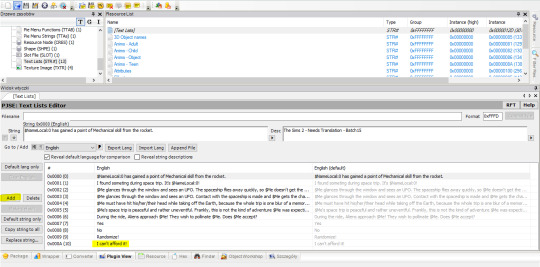
To make the usage of the rocket payable, you'd want to edit BHAV "Function - Ride - Start".

Click node 0x0. Using "Ins/false" button (it will appear after selecting "special buttons" checkbox) add node 0x1. Change node 0x1 to OpCode 0x0294 and node version to 0x00.
Click hammer and wrench icon and change the properties to something like mine:
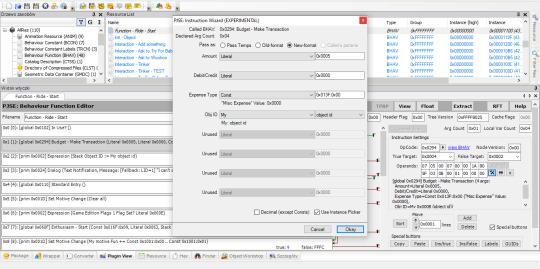
"Amount" is the cost of the ride. Debit/Credit should be set to 0 and expense type to Const 0x013F:0x00 ("Misc Expense"). As Obj ID set My object ID.
Then using "Ins/false" button add node 0x2. Chnage the OpCode to 0x0002 [prim 0x0002] Expression. Using hammer and wrench set it to Stack Object ID 0x0000 := My 0x000B (object id). Set "False Target" to "Error".

Then click "Ins/true". Change thr OpCode of the new node 0x3 to 0x0024 and the "True Target" to "Return True". Click the hammer and wrench icon. Change the properties in the dialog box as follows:

Click node 0x1 Budget - Make Transaction once again. Change the "True Target" to node 0x0004.
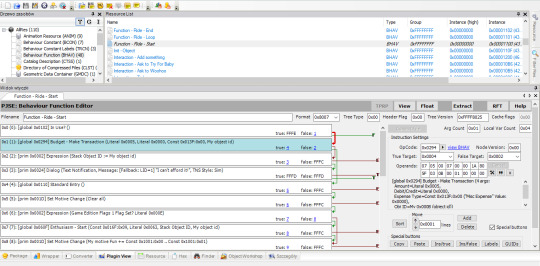
Click "Commit File" and save.
2. Altering the price of items brought from a trip
I haven't done anything like that in any of my mod or object. However, my educated guess is that maybe altering BHAV "Interaction - Add something" could work. This is my suggestion, but I have no idea if it is going to work:
In BHAV "Interaction - Add something" select node 0x9 (Create New Object Instance) and select "Ins/True".
Select new node 0xA. Change the OpCode to [prim 0x0002] Expression. Click on the hammer and wrench icon and change the properties to "Stack Object's 0x0029 (current value) := Stack Object's definition 0x0012 (price)".
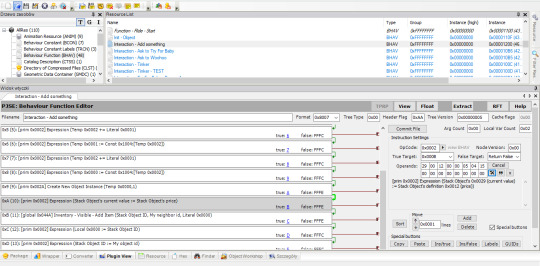
Then click "Ins/True" once more and select new node 0xB. Select the hammer and wrench icon and change the properties to "Stack Object's 0x0029 (current value) += Literal 0x0005". The "Literal" value in this case is how much you are going to increase object's price, so you can set it to whatever you like. Just remember that unless you tick the "decimal" box, the numbers are in hexadecimal system.

As I said, I don't know if it's going to work. Foremost, I don't know if changing the value in this manner is carried over if the object is added to Sim's inventory with the use of [global 0x044A] Inventory - Visible - Add Item.
It probably won't hurt to try it. 🤷♀️
12 notes
·
View notes
Text
I desprately need someone to talk to about this
I've been working on a system to allow a genetic algorithm to create DNA code which can create self-organising organisms. Someone I know has created a very effective genetic algorithm which blows NEAT out of the water in my opinion. So, this algorithm is very good at using food values to determine which organisms to breed, how to breed them, and the multitude of different biologically inspired mutation mechanisms which allow for things like meta genes and meta-meta genes, and a whole other slew of things. I am building a translation system, basically a compiler on top of it, and designing an instruction set and genetic repair mechanisms to allow it to convert ANY hexadecimal string into a valid, operable program. I'm doing this by having an organism with, so far, 5 planned chromosomes. The first and second chromosome are the INITIAL STATE of a neural network. The number and configuration of input nodes, the number and configuration of output nodes, whatever code it needs for a fitness function, and the configuration and weights of the layers. This neural network is not used at all in the fitness evaluation of the organism, but purely something the organism itself can manage, train, and utilize how it sees fit.
The third is the complete code of the program which runs the organism. Its basically a list of ASM opcodes and arguments written in hexadecimal. It is comprised of codons which represent the different hexadecimal characters, as well as a start and stop codon. This program will be compiled into executable machine code using LLVM IR and a custom instruction set I've designed for the organisms to give them a turing complete programming language and some helper functions to make certain processes simpler to evolve. This includes messages between the organisms, reproduction methods, and all the methods necessary for the organisms to develop sight, hearing, and recieve various other inputs, and also to output audio, video, and various outputs like mouse, keyboard, or a gamepad output. The fourth is a blank slate, which the organism can evolve whatever data it wants. The first half will be the complete contents of the organisms ROM after the important information, and the second half will be the initial state of the organisms memory. This will likely be stored as base 64 of its hash and unfolded into binary on compilation.
The 5th chromosome is one I just came up with and I am very excited about, it will be a translation dictionary. It will be 512 individual codons exactly, with each codon pair being mapped between 00 and FF hex. When evaulating the hex of the other chromosomes, this dictionary will be used to determine the equivalent instruction of any given hex pair. When evolving, each hex pair in the 5th organism will be guaranteed to be a valid opcode in the instruction set by using modulus to constrain each pair to the 55 instructions currently available. This will allow an organism to evolve its own instruction distribution, and try to prevent random instructions which might be harmful or inneficient from springing up as often, and instead more often select for efficient or safer instructions.
#ai#technology#genetic algorithm#machine learning#programming#python#ideas#discussion#open source#FOSS#linux#linuxposting#musings#word vomit#random thoughts#rant
7 notes
·
View notes
Text


If you told me this was how TI-83 binaries were structured, I would have straight up thought you were lying. JIT assembled from plaintext hex opcodes?--that can't be true. Maybe TI put that in the manual as a practical joke and nobody noticed.
...
...
...



Look at this stupid-ass hexdump. Every fucking byte of this file from 0x004B to 0x13C0 is either '0', '1', '2', '3', '4', '5', '6', '7', '8', '9', 'A', 'B', 'C', 'D', 'E', or 'F'.
This program is anti-compressed. Every byte of machine code is encoded as two bytes of plaintext characters.
Why would you ever do that. Why would you want your executable to stored as plaintext hex digits. It's certainly not for ease-of-editing--the file-initial "AsmPrgm" token (BBh 6Ch) prevents you from opening the file in the onboard editor--and it's definitely not for program integrity checking either. So why on Earth did TI think this was the move to make?
Baffling and upsetting. Thank god the execution model permits self-modifying and self-extracting compressed programs.
#i feel slightly sick#the 68k is such a wonderful platform and this is 100% gross and bad in comparison#my thoughts#programming#calculators#i68#maybe itll win me over with its addressing modes or something#given the z80 is based on an intel architecture i sincerely doubt it
106 notes
·
View notes
